The Evolution of Electron Dispersion in the Series of Rare-Earth Tritelluride Compounds Obtained from Their Charge-Density-Wave Properties and Susceptibility Calculations
Abstract
1. Introduction
2. Calculation
3. Results and Discussion
4. Conclusions
Author Contributions
Funding
Acknowledgments
Conflicts of Interest
References
- Yao, H.; Robertson, J.A.; Kim, E.A.; Kivelson, S.A. Theory of stripes in quasi-two-dimensional rare-earth tellurides. Phys. Rev. B 2006, 74, 245126. [Google Scholar] [CrossRef]
- DiMasi, E.; Aronson, M.C.; Mansfield, J.F.; Foran, B.; Lee, S. Chemical pressure and charge-density waves in rare-earth tritellurides. Phys. Rev. B 1995, 52, 14516. [Google Scholar] [CrossRef] [PubMed]
- Brouet, V.; Yang, W.L.; Zhou, X.J.; Hussain, Z.; Moore, R.G.; He, R.; Ru, N.; Lu, D.H.; Shen, Z.X.; Laverock, J.; et al. Angle-resolved photoemission study of the evolution of band structure and charge density wave properties in RTe3 (R = Y, La, Ce, Sm, Gd, Tb, and Dy). Phys. Rev. B 2008, 77, 235104. [Google Scholar] [CrossRef]
- Moore, R.G.; Brouet, V.; He, R.; Lu, D.H.; Ru, N.; Chu, J.H.; Shen, Z.X.; Fisher, I.R. Fermi surface evolution across multiple charge density wave transitions in ErTe3. Phys. Rev. B 2010, 81, 073102. [Google Scholar] [CrossRef]
- Schmitt, F.; Kirchmann, P.S.; Bovensiepen, U.; Moore, R.G.; Chu, J.H.; Lu, D.H.; Shen, Z.X.; Rettig, L.; Wolf, M.; Fisher, I.R. Ultrafast electron dynamics in the charge density wave material TbTe3. New J. Phys. 2011, 13, 063022. [Google Scholar] [CrossRef]
- Ru, N.; Condron, C.L.; Margulis, G.Y.; Shin, K.Y.; Laverock, J.; Dugdale, S.B.; Fisher, I.R. Effect of chemical pressure on the charge density wave transition in rare-earth tritellurides RTe3. Phys. Rev. B 2008, 77, 035114. [Google Scholar] [CrossRef]
- Ru, N.; Chu, J.-H.; Fisher, I.R. Magnetic properties of the charge density wave compounds RTe3 (R = Y, La, Ce, Pr, Nd, Sm, Gd, Tb, Dy, Ho, Er, and Tm). Phys. Rev. B 2008, 78, 012410. [Google Scholar] [CrossRef]
- Zocco, D.A.; Hamlin, J.J.; Grube, K.; Chu, J.H.; Kuo, H.H.; Fisher, I.R.; Maple, M.B. Pressure dependence of the charge-density-wave and superconducting states in GdTe3, TbTe3, and DyTe3. Phys. Rev. B 2015, 91, 205114. [Google Scholar] [CrossRef]
- Lavagnini, M.; Eiter, H.-M.; Tassini, L.; Muschler, R.; Hackl, R.; Monnier, R.; Chu, J.-H.; Fisher, I.R.; Degiorgi, L. Raman scattering evidence for a cascade evolution of the charge-density-wave collective amplitude mode. Phys. Rev. B 2010, 81, 081101(R). [Google Scholar] [CrossRef]
- Fang, A.; Ru, N.; Fisher, I.R.; Kapitulnik, A. STM Studies of TbTe3: Evidence for a Fully Incommensurate Charge Density Wave. Phys. Rev. Lett. 2007, 99, 046401. [Google Scholar] [CrossRef] [PubMed]
- Banerjee, A.; Feng, Y.; Silevitch, D.M.; Wang, J.; Lang, J.C.; Kuo, H.-H.; Fisher, I.R.; Rosenbaum, T.F. Charge transfer and multiple density waves in the rare earth tellurides. Phys. Rev. B 2013, 87, 155131. [Google Scholar] [CrossRef]
- Hu, B.F.; Cheng, B.; Yuan, R.H.; Dong, T.; Wang, N.L. Coexistence and competition of multiple charge-density-wave orders in rare-earth tritellurides. Phys. Rev. B 2014, 90, 085105. [Google Scholar] [CrossRef]
- Kogar, A.; Zong, A.; Dolgirev, P.E.; Shen, X.; Straquadine, J.; Bie, Y.Q.; Li, R. Light-Induced Charge Density Wave in LaTe3. arXiv 2019, arXiv:1904.07472. [Google Scholar]
- Sinchenko, A.A.; Lejay, P.; Monceau, P. Sliding charge-density wave in two-dimensional rare-earth tellurides. Phys. Rev. B 2012, 85, 241104(R). [Google Scholar] [CrossRef]
- Sinchenko, A.A.; Grigoriev, P.D.; Lejay, P.; Monceau, P. Spontaneous Breaking of Isotropy Observed in the Electronic Transport of Rare-Earth Tritellurides. Phys. Rev. Lett. 2014, 112, 036601. [Google Scholar] [CrossRef]
- Sinchenko, A.A.; Grigoriev, P.D.; Lejay, P.; Monceau, P. Linear magnetoresistance in the charge density wave state of quasi-two-dimensional rare-earth tritellurides. Phys. Rev. B 2017, 96, 245129. [Google Scholar] [CrossRef]
- Frolov, A.V.; Orlov, A.P.; Grigoriev, P.D.; Zverev, V.N.; Sinchenko, A.A.; Monceau, P. Magnetoresistance of a Two-Dimensional TbTe3 Conductor in the Sliding Charge-Density Wave Regime. JETP Lett. 2018, 107, 324. [Google Scholar] [CrossRef]
- Savrasov, S.Y.; Savrasov, D.Y. Electron-phonon interactions and related physical properties of metals from linear-response theory. Phys. Rev. B 1996, 54, 16487. [Google Scholar] [CrossRef]
- Dorenbos, P. The electronic level structure of lanthanide impurities in REPO4, REBO3, REAlO3, and RE2O3 (RE = La, Gd, Y, Lu, Sc) compounds. J. Phys. Condens. Matter 2013, 25, 225501. [Google Scholar] [CrossRef]
- Wunderlich, W.; Ohsato, H. Enhanced Microwave Resonance Properties of Pseudo-Tungsten-Bronze Ba6−3xR8+2xTi18O54 (R = Rare Earth) Solid Solutions Explained by Electron–Phonon Interaction. J. Jpn. Appl. Phys. 2013, 52, 09KH04. [Google Scholar] [CrossRef]
- Lee, J.; Ohba, N.; Asahi, R. First-principles prediction of high oxygen-ion conductivity in trilanthanide gallates Ln3GaO6. Sci. Technol. Adv. Mater. 2019, 20, 144–159. [Google Scholar] [CrossRef] [PubMed]
- Landau, L.D.; Lifshitz, E.M. Statistical Physics. In Course of Theoretical Physics, 3rd ed.; Nauka: Moscow, Russia, 1976; Pergamon Press: Oxford, UK, 1980; Volume 5. [Google Scholar]
- Grüner, G. Density Waves in Solids, 1st ed.; Perseus Publishing: Cambridge, MA, USA, 2000. [Google Scholar]
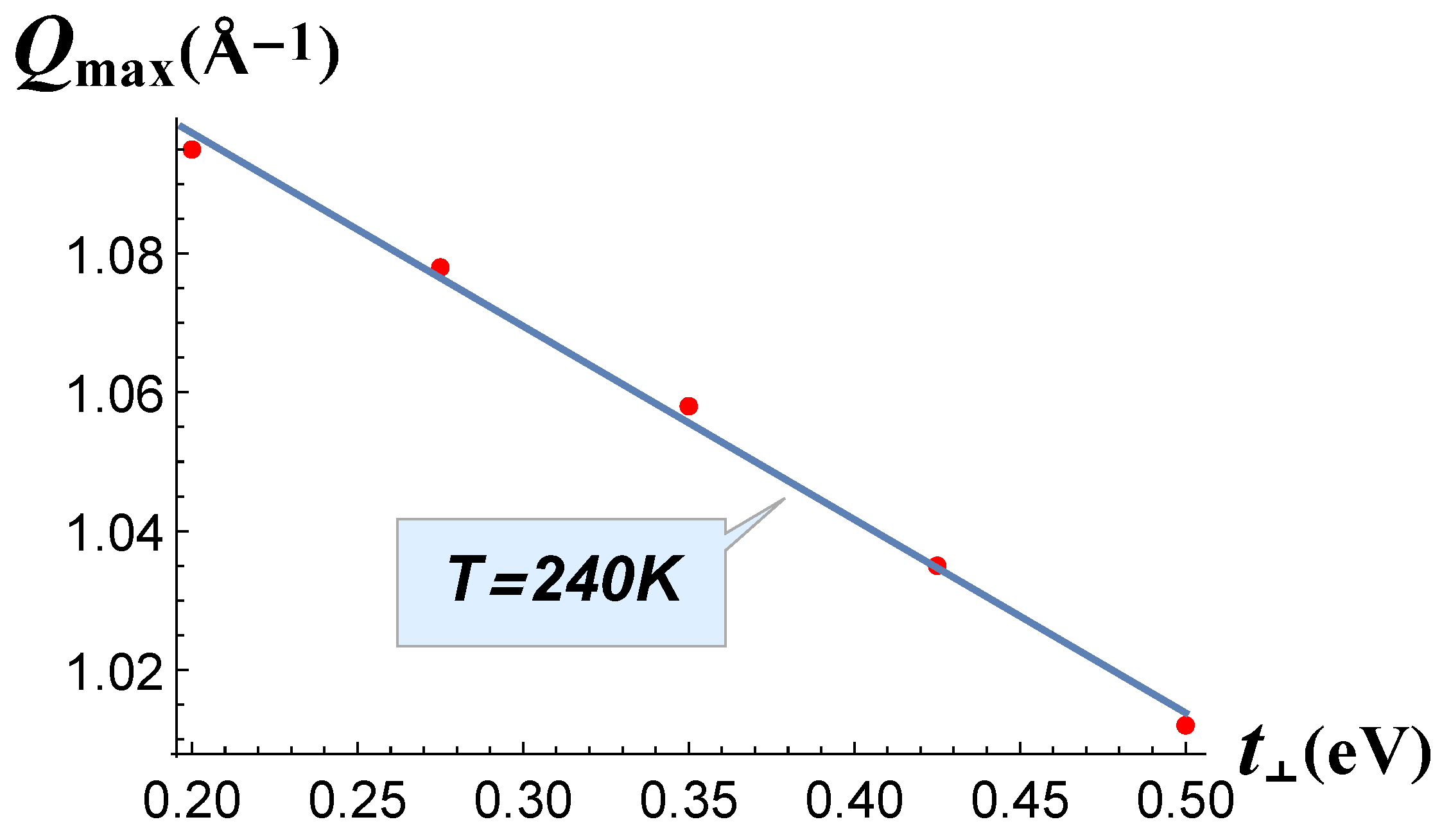
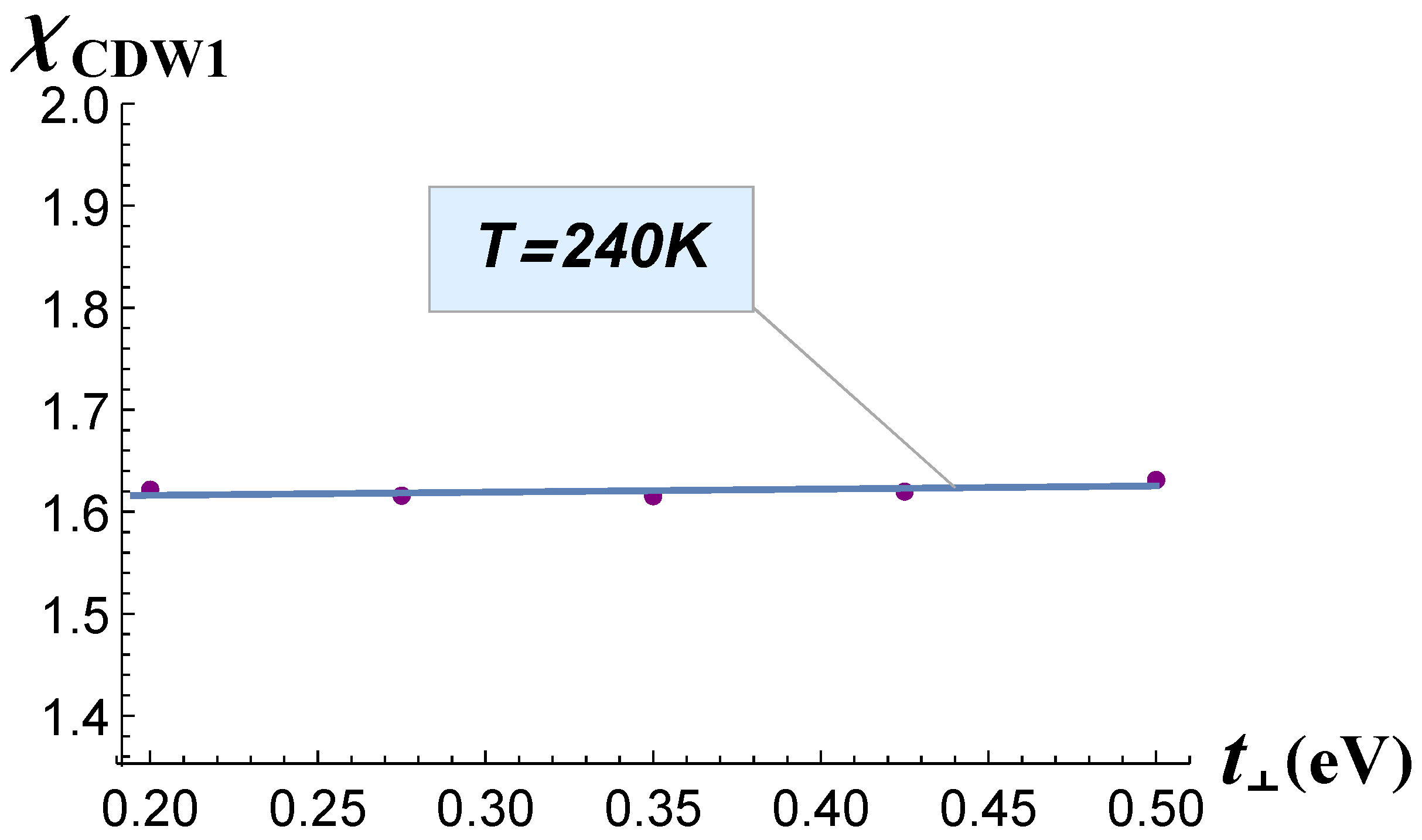

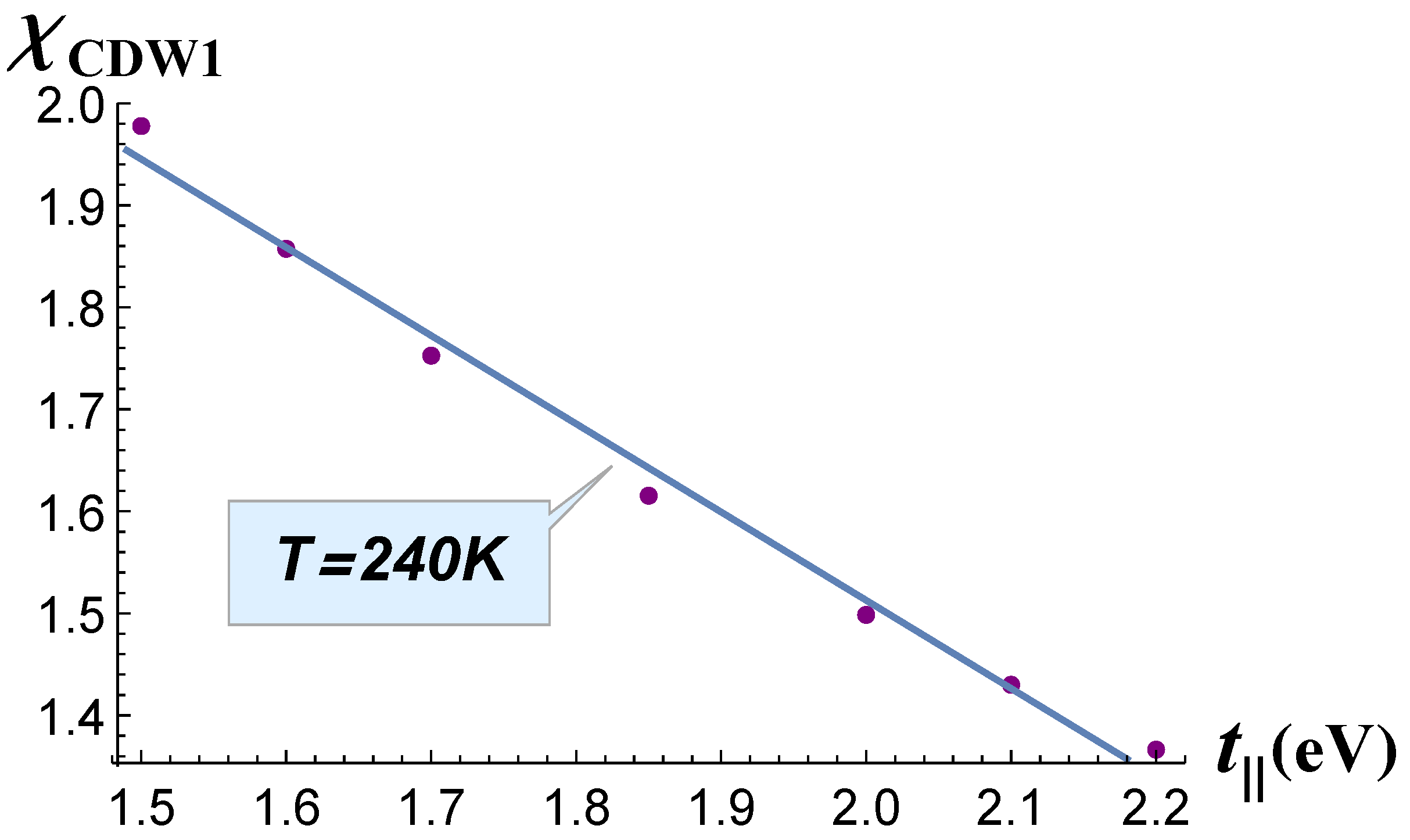
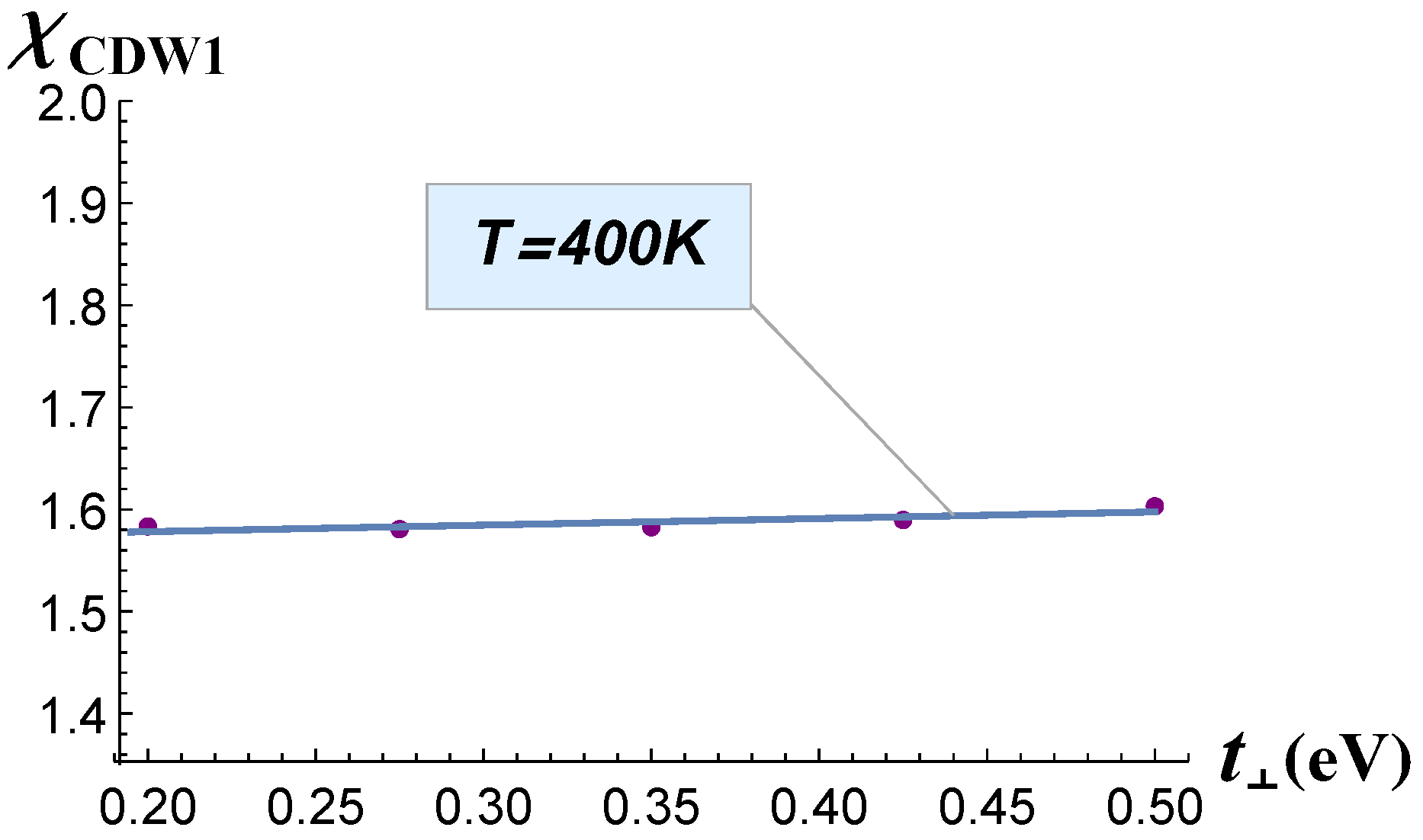
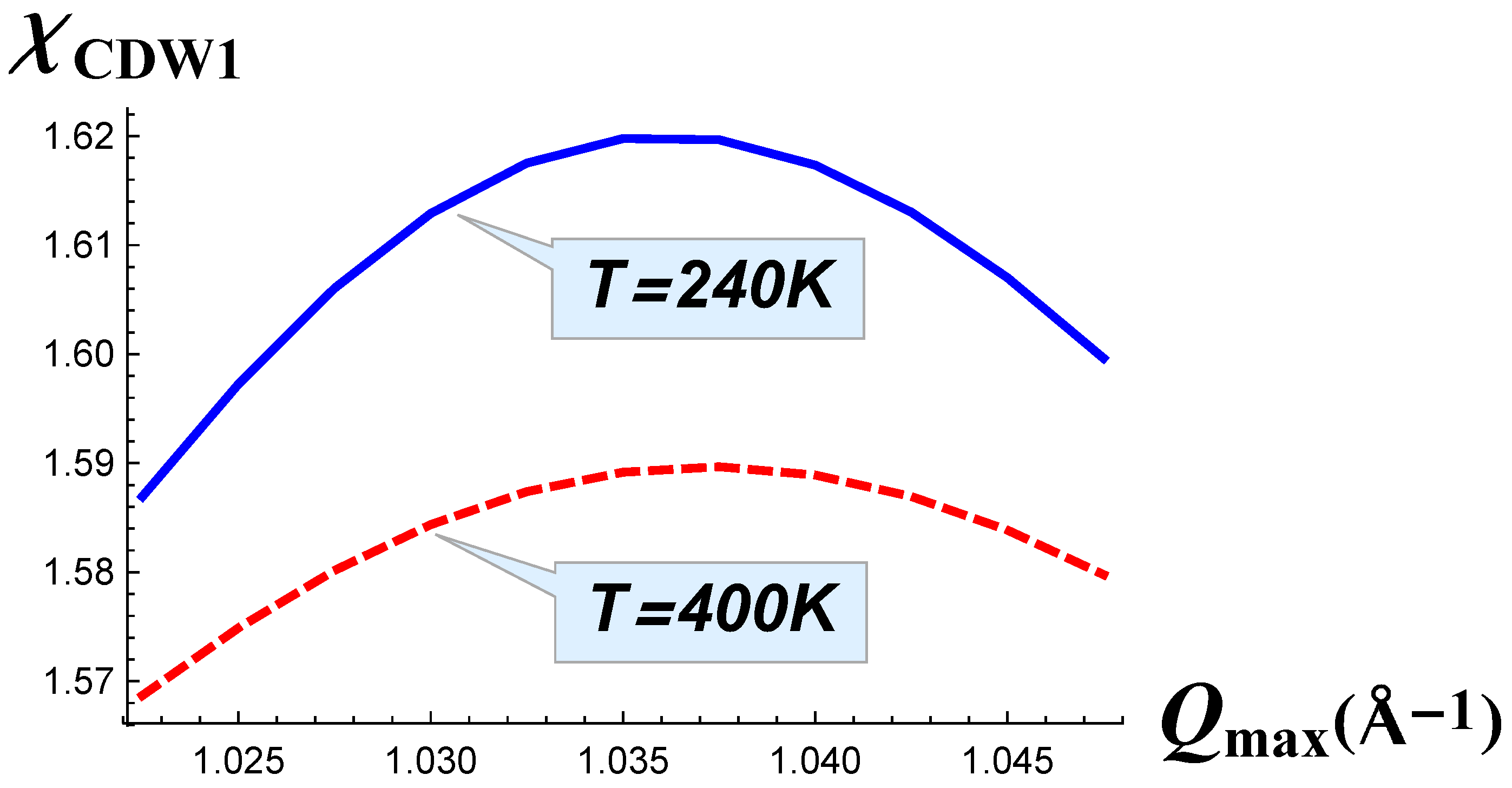
| Compound | [6], K | [6], K | Lattice Parameter [6], Å | , eV | , eV | , eV |
|---|---|---|---|---|---|---|
| GdTe3 | 377 | - | 4.320 | ≈1.37 | >0.35 | 0.95 |
| DyTe3 | 306 | 49 | 4.302 | 1.85 [3] | 0.35 [3] | 1.28 |
| HoTe3 | 284 | 126 | 4.290 | 1.96 | <0.35 | 1.35 |
| ErTe3 | 267 | 159 | 4.285 | 2.06 | <0.35 | 1.42 |
| TmTe3 | 244 | 186 | 4.275 | 2.20 | <0.35 | 1.52 |
© 2019 by the authors. Licensee MDPI, Basel, Switzerland. This article is an open access article distributed under the terms and conditions of the Creative Commons Attribution (CC BY) license (http://creativecommons.org/licenses/by/4.0/).
Share and Cite
Vorobyev, P.A.; Grigoriev, P.D.; Kesharpu, K.K.; Khovaylo, V.V. The Evolution of Electron Dispersion in the Series of Rare-Earth Tritelluride Compounds Obtained from Their Charge-Density-Wave Properties and Susceptibility Calculations. Materials 2019, 12, 2264. https://doi.org/10.3390/ma12142264
Vorobyev PA, Grigoriev PD, Kesharpu KK, Khovaylo VV. The Evolution of Electron Dispersion in the Series of Rare-Earth Tritelluride Compounds Obtained from Their Charge-Density-Wave Properties and Susceptibility Calculations. Materials. 2019; 12(14):2264. https://doi.org/10.3390/ma12142264
Chicago/Turabian StyleVorobyev, Pavel A., Pavel D. Grigoriev, Kaushal K. Kesharpu, and Vladimir V. Khovaylo. 2019. "The Evolution of Electron Dispersion in the Series of Rare-Earth Tritelluride Compounds Obtained from Their Charge-Density-Wave Properties and Susceptibility Calculations" Materials 12, no. 14: 2264. https://doi.org/10.3390/ma12142264
APA StyleVorobyev, P. A., Grigoriev, P. D., Kesharpu, K. K., & Khovaylo, V. V. (2019). The Evolution of Electron Dispersion in the Series of Rare-Earth Tritelluride Compounds Obtained from Their Charge-Density-Wave Properties and Susceptibility Calculations. Materials, 12(14), 2264. https://doi.org/10.3390/ma12142264






